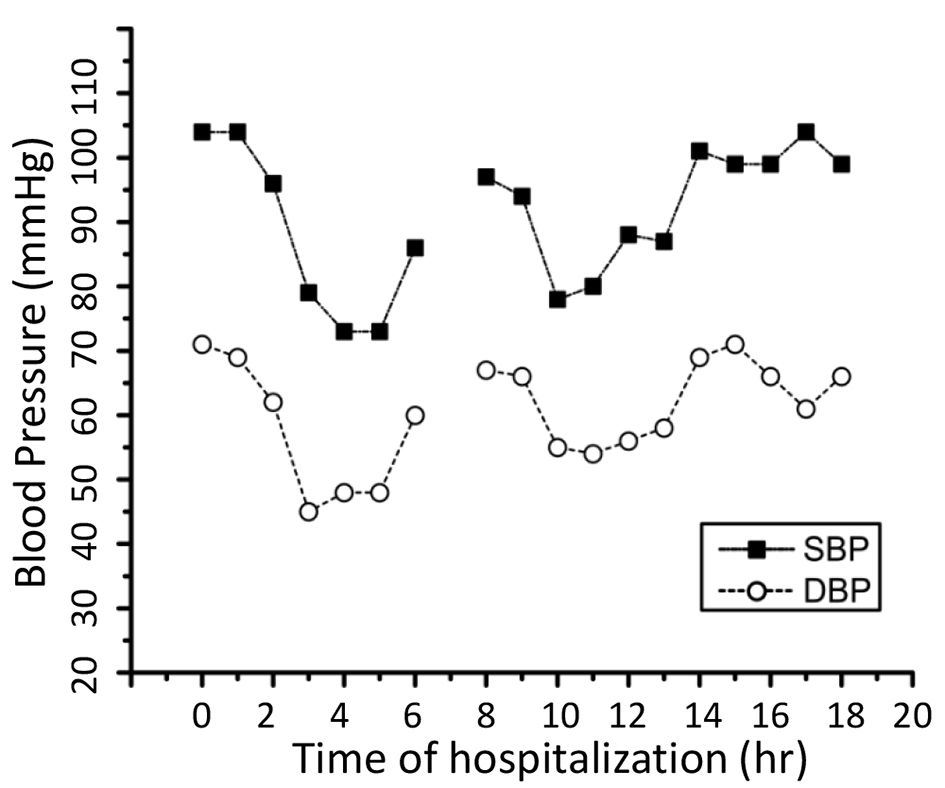
Figure 1. Copy of AICD interrogation showing the occurrence of V-tach/vib. The verical dash line indicates the shock. The trace shows the V-fib episode on the day of admission, which was promptly terminated by ICD.
| Journal of Clinical Medicine Research, ISSN 1918-3003 print, 1918-3011 online, Open Access |
| Article copyright, the authors; Journal compilation copyright, J Clin Med Res and Elmer Press Inc |
| Journal website http://www.jocmr.org |
Case Report
Volume 8, Number 8, August 2016, pages 610-615
Convulsive Syncope Induced by Ventricular Arrhythmia Masquerading as Epileptic Seizures: Case Report and Literature Review
Figures


Tables
| Result | Normal range | |
|---|---|---|
| CK: creatinine phospho-kinase; BNP: brain natriuretic peptide; GFR-AA: estimated glomerular filtration rate for African American. | ||
| Sodium | 131 | 136 - 146 mEq/L |
| Potassium | 3.0 | 3.5 - 5.0 mEq/L |
| Chloride | 90 | 3.5 - 5.0 mEq/L |
| Bicarbonate | 30 | 23 - 29 mEq/L |
| Blood urea nitrogen | 50 | 7 - 18 mg/dL |
| Creatinine | 2.29 | 0.5 - 1.2 mg/dL |
| Glucose | 120 | 70 - 105 mg/dL |
| GFR-AA | 36 | ≥ 60 mL/min/1.73 m2 |
| Hemoglobin | 13.6 | M: 13.5 - 17.5 g/dL |
| Hematocrit | 43.7 | M: 41-53% |
| Troponin I | 0.07 → 0.06 → 0.04 | < 0.4 ng/mL |
| CPK | 58 → 55 → 44 | 38 - 120 ng/mL |
| BNP | 196 | < 100 pg/mL |
| Syncope | Seizures | |
|---|---|---|
| *In the presence of convulsion, postictal drowsiness may not differ between patients with or without syncope [37]. GTCS: generalized tonic-clonic seizure; SGTCS: secondarily generalized tonic-clonic seizure; HTN: hypertension; CAD: coronary artery disease; N/V: nausea/vomiting; CK: creatinine kinase. | ||
| Before spells | ||
| Precipitants | Frequent, prolonged standing/sitting, violent coughing, pain, micturation, defecation, warn/hot environment, exertion, antihypertensive drugs, blood loss, venipuncture, alcohol, HTN, CAD | Rare, stress |
| Prodrome | Gradual evolution, especially in young patients: N/V, abdominal discomfort, heat/cold, sweating, chest pain, dyspnea, light-headedness, headache, blurred vision, amaurosis, tinnitus, weakness | Deja vu, preoccupation, hallucination, mood changes, somatosensory auras, trembling |
| Position | Usually standing or sitting | Any |
| Blanks | “Fading away” in young, or abrupt loss in elderly patients | Abrupt loss |
| During spells | ||
| Falls | Slow, flaccid | Fast, tonic |
| Skin | Pale | Blue face, sometimes acrocyanosis |
| Convulsion | Common, start after LOC, prolonged, arrhythmic, asynchronous, small | Typical, coincide with LOC, short, rhythmic, synchronous, coarse |
| Automatism | Rare, short, solitary | Common |
| Tongue biting | Uncommon, tip of tongue | Common, side of tongue |
| Eye deviation | Transient lateral or upward | Sustained lateral |
| Incontinence | Common | Common |
| Duration | 3 - 30 s | GTCS: 30 s - 5 m SGTCS: 16 - 108 s |
| After spells | ||
| Postictal state* | Short, mostly last < 30 s | Prolonged confusion, 2 - 20 m |
| Physical findings | Bradycardia, hypotension | Focal neurological abnormalities |
| Laboratory | Normal CK, prolactin | Increased CK, prolactin |
| Cardiac arrhythmia | Common | Rare, except sinus tachycardia |
| EEG | Slow, flat waves | Focal or general spike activity |
| Questions | Points if yes |
|---|---|
| Seizure if total score ≥ 1; syncope if < 1. | |
| Tongue biting? | 2 |
| Sense of deja vu or jamais vu before spells? | 1 |
| Emotional stress associated with LOC? | 1 |
| Witnessed head turning during spells? | 1 |
| Witnessed unresponsiveness? Unusual posturing? Jerking limbs? No memory of spells afterwards? (score for any positive response) | 1 |
| Witnessed confusion after spells? | 1 |
| Lightheaded spells? | -2 |
| Sweating before spells? | -2 |
| Prolonged sitting or standing associated with spells? | -2 |